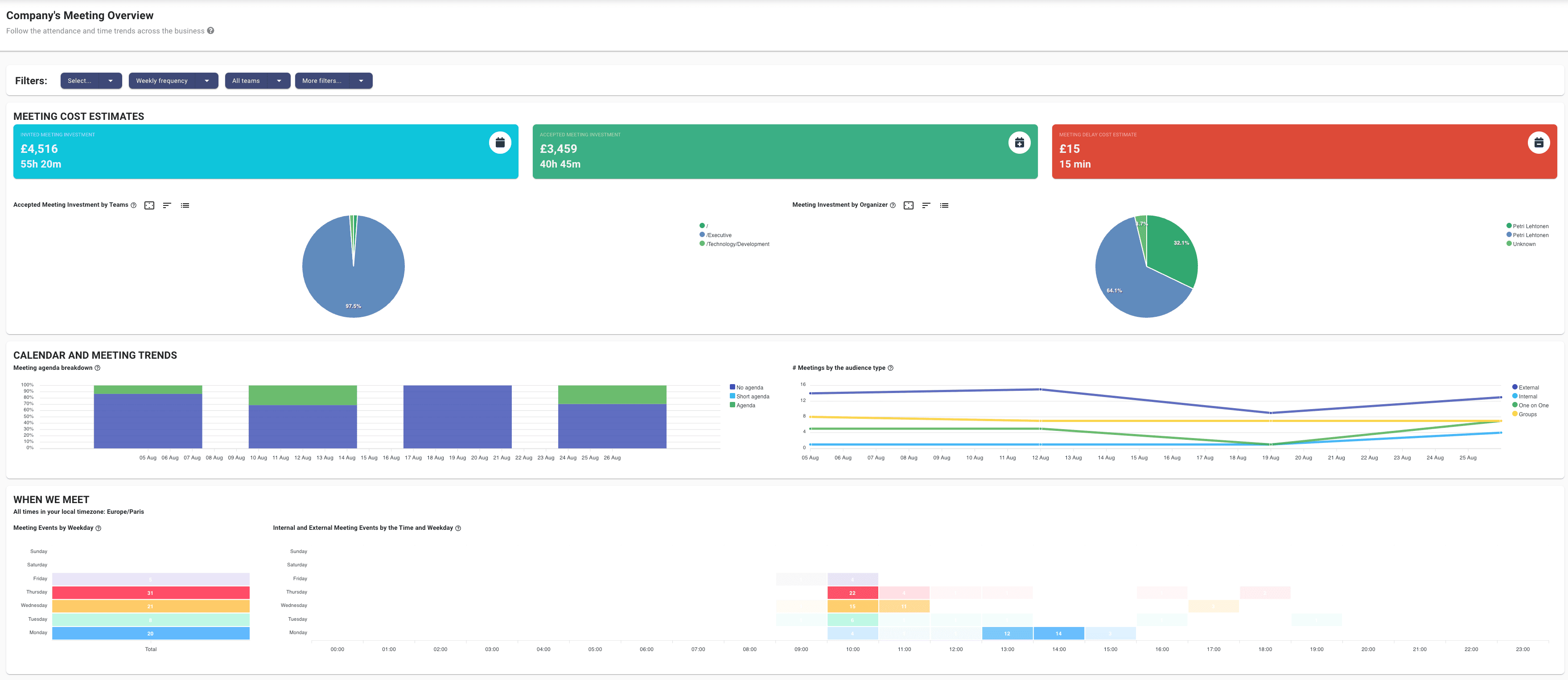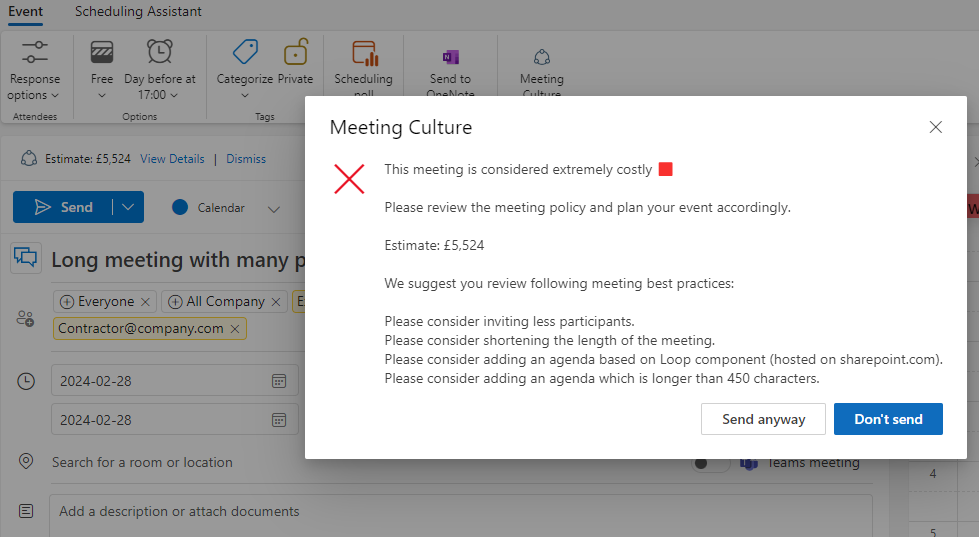Meeting ROI: The Power of Efficient Meetings
Discover the power of efficient meetings and how measuring ROI can improve productivity, engagement, and decision-making. Learn how tools like...
Optimize your meetings by using strategic meeting management with analytics to boost productivity, reduce costs, and enhance collaboration.
In modern organizations, effective meeting management is essential for maintaining productivity, collaboration, and achieving strategic goals. However, without a clear and structured approach, meetings can quickly drain resources, contributing to wasted time, unnecessary costs, and reduced employee engagement. Strategic meeting management provides a framework for optimizing every aspect of meetings ensuring they are purposeful, efficient, and aligned with business objectives.
Central to this optimization is the use of meeting analytics. By utilizing data, organizations can monitor key aspects of their meeting practices, such as duration, attendance patterns, and costs. Analytics provide a clear understanding of what works and what doesn’t, allowing teams to make informed adjustments that improve meeting outcomes. This approach can drive meetings into value-driven engagements that enhance organizational efficiency and support strategic success.
Creating a baseline of current meeting practices is essential for organizations aiming to implement meaningful changes. A baseline allows for the measurement of progress and the identification of areas needing improvement. Without this initial assessment, efforts to enhance meeting efficiency may lack direction and measurable outcomes.
Collecting and analyzing meeting metrics enables organizations to discover inefficiencies and patterns in their meeting practices. For instance, data may reveal that certain recurring meetings consistently exceed their scheduled time without yielding actionable outcomes, indicating a need for restructuring or elimination. According to a study by Forbes, 71% of senior managers reported that meetings are unproductive and inefficient, highlighting the widespread nature of this issue.
To establish an effective baseline, organizations should monitor several critical meeting metrics:

By establishing a baseline through meeting analytics, organizations can make informed decisions to optimize their meeting culture, leading to improved productivity and resource management.
Utilizing meeting analytics enables organizations to identify inefficiencies and implement targeted improvements, enhancing productivity and resource utilization.
Analytics can uncover specific issues contributing to meeting fatigue, elevated costs, and wasted time. For example, data may reveal that certain meetings consistently exceed their scheduled duration without achieving clear outcomes, indicating a need for better time management or agenda setting. Additionally, tracking attendance patterns can highlight meetings with low engagement, suggesting they may be unnecessary or require restructuring.
Once pain points are identified, organizations can make strategic changes informed by data:

By comparing the costs associated with meetings, such as employee time and resources, to their outcomes, organizations can assess the return on investment (ROI) for each session. This evaluation helps determine whether meetings justify their expense or if alternative communication methods would be more effective. Implementing such assessments ensures that meetings contribute positively to organizational goals and resource allocation.
Organizations must take a continuous improvement approach to fully optimise meeting practices, leveraging analytics to set goals, gather feedback, and track trends over time. This cycle ensures that meeting management evolves in response to changing needs and insights, ultimately driving greater productivity and engagement.
Analytics can help organizations establish clear goals and key performance indicators (KPIs) for their meetings. Whether the objective is to reduce meeting costs, boost engagement, or improve outcomes, setting measurable targets allows for focused improvements. For example, a company might aim to decrease meeting duration by 20% over a quarter or achieve a specified level of participation in critical discussions. By tracking these KPIs, leaders can assess whether their strategies are effective and adjust as needed.
Collecting feedback from meeting participants is vital for informed adjustments to meeting practices. Surveys, polls, or direct feedback during follow-ups provide insights into what works and what doesn’t. Participants may highlight issues like unclear agendas, unproductive discussions, or scheduling conflicts that analytics alone may not capture. This feedback allows organizations to address concerns, refine practices, and foster a meeting culture that values productivity and participant satisfaction.
Long-term data tracking enables organizations to identify patterns and trends in their meeting practices. Over time, analytics can reveal shifts in meeting frequency, duration, or engagement levels, indicating whether implemented changes are effective or if further adjustments are necessary. Continuous monitoring ensures that meeting strategies remain relevant and aligned with organizational goals, minimizing wasted time and maximizing value. By maintaining this focus, teams can adapt their approaches, creating a dynamic and effective meeting culture that supports overall business success.
.png?width=1366&height=768&name=Outlook%20Add%20In%20Store%20Images%20-%201%20(1).png)
To optimize meetings, seamless integration with everyday tools like Google Calendar and Microsoft Outlook is essential. Flowtrace’s Chrome Extension and Microsoft Add-In provide this capability by offering features that enhance meeting structure, cost transparency, and overall effectiveness directly within these platforms. By leveraging these integrations, organizations can gain valuable insights and improve meeting practices within their familiar email and scheduling tools.
The Flowtrace extension for Google Calendar and the add-in for Microsoft Outlook integrate provides users with the ability to calculate meeting costs in real-time and embed meeting policies into invites. This functionality supports leaders in managing meeting expenses and ensuring that meetings are purposeful and structured.


The integration of Flowtrace’s meeting cost calculation and policy-setting capabilities with Google Calendar and Microsoft Outlook empowers organizations to act on meeting insights directly within their everyday tools. This functionality helps leaders prioritize meetings that offer true value, establish clear structures, and manage costs with precision. By focusing on cost transparency and adherence to meeting policies, Flowtrace enhances productivity and supports intentional, goal-driven meetings.
Effective meeting management requires a structured approach that maximizes value and minimizes disruptions. By adopting practical strategies, organizations can ensure their meetings are purposeful, efficient, and aligned with broader productivity goals.
Setting up clear guidelines for meetings is crucial for optimizing their outcomes:

Minimizing disruptions caused by meetings is essential for preserving time for deep, focused work:

Encouraging teams to engage with meeting data fosters a culture of continuous improvement:
By implementing these practical strategies, organizations can transform meetings into focused, outcome-driven engagements that support productivity and respect employees’ time. Balancing structured meeting practices with opportunities for deep work fosters an environment where both collaboration and individual contributions can thrive.
Using analytics for strategic meeting management provides organizations with a powerful means to reduce costs, improve productivity, and enhance overall meeting effectiveness. By tracking key metrics and implementing data-driven strategies, companies can transform meetings from potential drains on resources into highly focused, value-driven engagements. Analyzing meeting data enables leaders to make informed decisions, optimize meeting practices, and create a balanced culture that prioritizes meaningful collaboration and efficient use of time. Flowtrace helps businesses cultivate a meeting culture that drives productivity, accountability, and long-term success.
Discover the power of efficient meetings and how measuring ROI can improve productivity, engagement, and decision-making. Learn how tools like...
Optimize meeting productivity with visual analytics for meeting data. Transform raw data into actionable insights, streamline meetings, and enhance...
Discover how to stop the meeting madness and combat meeting overload to enhance productivity with strategic, data-driven approaches for effective and...